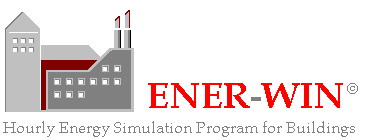
Technical Basis (See also
Technical Publications List)
(1) Weather data generation:
Weather data generation is done hour-by-hour, producing hourly values for
dry-bulb temperature, dew-point temperature, wind speed, sun angles, cloud cover fraction, and direct and diffuse insolation. Luminous values
used for daylighting calculations are derived from the thermal radiation
by use of a luminous efficacy algorithm.
(2) Envelope material cataloging:
The envelope material cataloging permits any wall, roof, or glazing assembly to be specified and entered in a simple, numbered catalog. The material specifications require the assemblyís thermal conductance, thermal capacitance (time lag), and the absorptivity of the outside surface to solar radiation. Glazing assemblies require input of overall thermal conductance, thermal radiation transmissivity, emissivity, and luminous transmissivity. ENER-WIN allows up to
30 building types, 20 each of wall and window types, and these can be applied to up to 400 wall surfaces in one simulation run.
(3) User profile cataloging:
The user profile cataloging permits the user to specify multiple profiles of hourly patterns of occupancy, hot water usage, lighting, electric loads, ventilation rates, normal summer and winter temperature settings, and holiday summer and winter setbacks.
(4) Zone processing:
The zone processing involves linking the zones to the profile numbers and
specifying the other zone related parameters. These parameters include the floor
area, ceiling height, interior mass, use schedules/profiles, lighting type, mechanical system type
, heating fuel type, economizer cooling, ventilation rates and daylighting parameters. Peak values for occupancy, hot water use, ventilation, lighting, and equipment are also linked to the respective profile numbers.
(5) Building geometry processing:
The building's geometry is derived from a simple Graphic User Interface (GUI)
for drawing the building plans that show thermal zones (rooms) and location of
walls and windows.
The results of the drawing routines provide the floor areas, envelopeís areas, orientations, slope, shading, and exposure to the specified ground cover. Shade types include diffuse screens, venetian blinds, overhangs, adjacent building, and trees. Ground surface exposures include selection from both natural and paved materials.
(6) Load calculations:
Loads calculations, system simulations, and energy summations are performed simultaneously for each of the 8760 hours in a year and are based on the generated exterior weather conditions and the interior temperature profiles and loads. The simulationís
transient modeling is based on sol-air temperature, component time lag, decrement
factor and a heat balance method (HBM) using the building's internal thermal mass
for time lag calculations.
(7) System simulations:
The system is initially sized for the hottest month, but may be resized numerous
times, if necessary, when a new peak load is encountered. The energy
calculations are based on embedded system efficiencies that are typical of the
system chosen from the available 12 system types.
(8) Energy summations:
The program outputs a monthly summary of the various categories of energy use, as well as peak demands and utility bills. At the end of the simulation cycle, the site line and source energy utilization
index (EUIís) are printed. Peak load breakdowns and dates of occurrence for heating and cooling are also tabulated.
(9) Life-cycle cost predictions:
ENER-WIN processes the life-cycle cost projection. First costs of the building are computed based on the unit cost of walls, windows, and roofs; the floor construction cost; lighting system cost; and mechanical system cost. ENER-WIN then performs a present worth
(PW) analysis to include the future recurring costs of fuel, electric, and maintenance cost
as well as fuel price escalation rates.
Other ENER-WIN Topics:
s
 Back to ENER-WIN.
Back to ENER-WIN.
